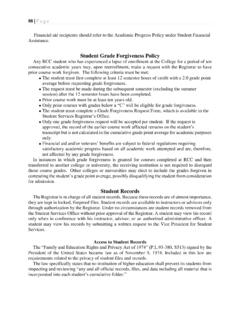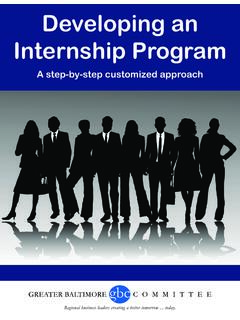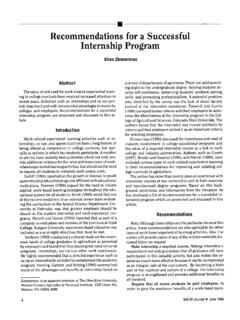Transcription of Employer Guide to Organizing a Successful Internship Program
1 The experienced employees who required very little, if any, training. But this dream conflicts with reality. How can organizations meet the needs of today and prepare the workforce for the future? One solution is to develop a quality Internship Program . BE BRAVE. TAKE RISKS. NOTHING CAN SUBSTITUTE EXPERIENCE. Employer Guide to Organizing a Successful Internship Program 2 The Expert in anything was once a Beginner Table of Contents What Is the Best Experiential Option for Your Organization? .. 3 A Closer Look at an Internship ? .. 4 How do employers benefit from an Internship Program ? .. 4 Benefits to Employers .. 4 Designing an Internship Program that Meets Your Needs .. 5 Step 1: Set Goals .. 5 Step 2: Write a Plan.
2 5 Step 3: Supervising the intern(s) .. 6 Finding the Right Intern for Your Organization .. 6 Making an Internship Offer .. 7 Benefits to Students .. 7 Learning Goals .. 7 Designing Your Internship Program .. 8 Role of an Internship Supervisor and Mentor .. 8 Role of a Mentor .. 8 Orienting and Training 9 Key Points .. 10 Orientation Checklist .. 10 Paying an Intern .. 11 Workers and Unemployment Compensation .. 12 Keep in Mind .. 12 Writing an Internship Posting 12 Evaluations .. 13 Conclusion .. 13 Resources .. 13 3 The Expert in anything was once a Beginner What Is the Best Experiential Option for Your Organization? Experiential Learning provides students with direct experience through which they can use analytical skills and reflection to apply new ideas gained from the experience to their classroom learning.
3 Experiential learning includes internships, service learning, and various practicum opportunities. Determine what the best fit for the organization is by considering the following definitions: Volunteer is a person who performs a service willingly, without pay or credit in order to support a cause. Service Learning is curriculum-based emphasizing hands-on learning while addressing real world concerns. The service experience provides a context for translating discipline based theories into practice. Civic Engagement offers a broad concept of community involvement and awareness that can include service, advocacy, service learning, volunteerism and political participation, with the goal of helping to develop community based knowledge, values and skills.
4 Capstone/Project Based Learning course is the culmination of learning in the major. A student generally works on a single large project-such as a thesis paper or large research project-for the entire semester. Externships (Job Shadow) provide an initial exposure to a career for a brief period of time (such as one day a week or a couple hours per week) by having students shadow an experienced employee or professional. Externships may include academic credit when connected to a course. Internships are defined by the National Association of Colleges and Employers (NACE) as: a form of experiential learning that integrates knowledge and theory learned in the classroom with practical application and skills development in a professional setting.
5 Internships give students the opportunity to gain valuable applied experience and make connections in professional fields they are considering for career paths; and give employers the opportunity to Guide and evaluate talent. In addition, an Internship is a semester (fall, spring, summer) in duration, may or may not carry credit, may be paid or unpaid based on the Department of Labor criteria (See Page 11 for DOL Requirements). A Student Employee is a person who is hired to provide services to an organization on a regular basis in exchange for compensation, not for academic credit. This is appropriate when you don t meet Department of Labor 6 Prong test. (See page 11) Apprenticeship is a combination of on-the-job training and related instruction in which workers learn the practical and theoretical aspects of a highly skilled occupation.
6 Apprenticeship programs can be sponsored by individual employers, joint Employer and labor groups, and/or Employer associations. After completing an apprenticeship Program , the worker's journey-level status provides an additional benefit of nationwide mobility at journey level scale. 4 The Expert in anything was once a Beginner A Closer Look at an Internship ? Often times an Internship is the ideal fit for an individual and Employer . An Internship is any carefully monitored meaningful learning experience in which a individual has intentional professional goals and reflects actively on what he or she is accomplishing throughout the experience. Developing an Internship Program is an excellent strategy for investing in your organization s future successes, often leading to discovering future colleagues and leaders.
7 A typical Internship : Includes developing intentional learning objective goals that are structured into the experience and supervised by a professional with relevant and related background in the field. Promotes academic, career and/or personal development. Includes learning objectives, observation, reflection, and evaluation. Balances the intern s learning goals with the organization s needs. Typically lasts three months. May be part-time or full-time. Involves industry related and soft skill development. May be carefully monitored and evaluated for academic credit. Provides adequate supervision in a reasonably safe environment with the necessary tools to perform the learning goals agreed upon for the duration of the Internship .
8 An Internship is not: Free help. Meant to replace an employee. More than 20% busy work (filing, covering phone, errands). How do employers benefit from an Internship Program ? One of the more significant advantages to providing internships is the opportunity to select and develop your future talent. You have the opportunity to evaluate and screen potential employees prior to making a full-time position offer, which leads to financial savings. Employers have reported converting more than half of eligible interns into full-time hires. If hired in a permanent position, previous interns assimilate faster to their new roles and have shorter learning curves than external hires. Benefits to Employers Provide freedom for professional staff to pursue creative or more advanced projects.
9 Increase staff retention rate. Assist an organization in application of the latest strategies and techniques in the field. Maintain connections with colleges and increase visibility on campus. Promote community involvement-excellent public relations tool. Recruit other students and generate enthusiasm. Creates awareness of the field for future hires. Giving to the community by teaching the prospective work force. 5 The Expert in anything was once a Beginner Designing an Internship Program that Meets Your Needs As varied as companies are in age, size, industry and product, so too are their Internship activities. How do you know what kind of Program will work best for you? Designing an Internship Program to meet needs is as easy as five steps.
10 To determine is an intern is the right choice for your company, ask the following questions: Are there specific projects or assignments that will provide quality working and learning opportunity for an intern? Can the company commit time to develop a student, promote community goodwill, and offer insight into the organization? Are there any benefits from the latest technology, perspectives, and relevant skills being used in our school? Does the company have a desire to help mold the future of the workforce s talent? If you answered yes to all of these questions, then you are ready to support an intern! Step 1: Set Goals What does the Employer hope to achieve from the Program ? Is the Employer a small company searching for additional help on a project?




